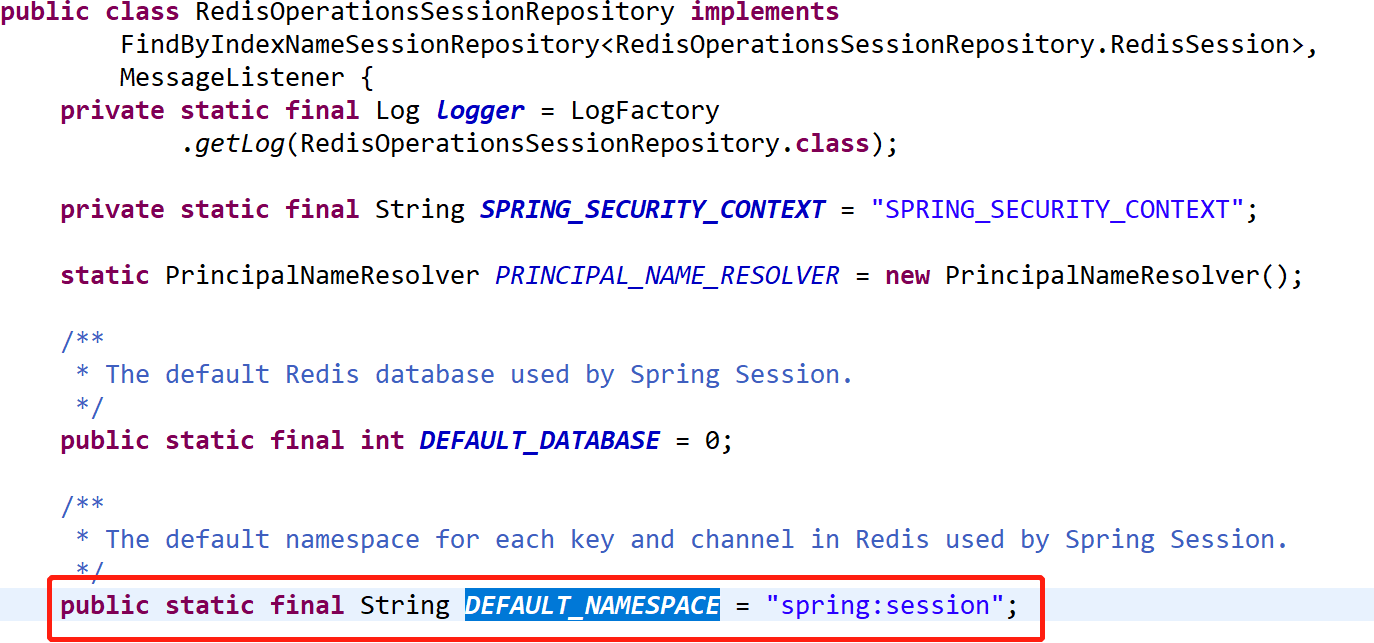在谈到集群方案的时候,第一个会遇到的问题就是session问题,在单机上,session的问题从来都是web容器解决的,我们主要是用,但是集群意味着多容器。如果负载均衡是随机分配服务器访问的话,很容易造成在A服务器登录后,下次访问是走的是B服务器,结果B服务器的web容器里面并没有该用户的session,结果就悲剧了。那么怎么办呢,当然是redis来处理,redis把session集中存储起来,不管哪台服务器存取session都是走redis,本地服务器不保存session,这个问题就完美的解决了。这个方案落到具体的实现上,首先我想到的就是spring自己的解决方案,spring session。
1、spring session+redis跑起来
spring session+redis的方案非常的简单,大家请按步骤来:
步骤1:pom文件加starter
<dependency>
<groupId>org.springframework.boot</groupId>
<artifactId>spring-boot-starter-data-redis</artifactId>
</dependency>
<dependency>
<groupId>org.springframework.boot</groupId>
<artifactId>spring-boot-starter-web</artifactId>
</dependency>
<dependency>
<groupId>org.springframework.session</groupId>
<artifactId>spring-session-data-redis</artifactId>
</dependency>spring-boot-starter-web是引入web依赖,spring-boot-starter-data-redis是redis的存取,spring-session-data-redis就是把redis作为session的存储位置并做相关操作的依赖。
步骤2:把redis的配置写到application.properties里面去
# REDIS
# Redis数据库索引(默认为0)
spring.redis.database=0
# Redis服务器地址
spring.redis.host=myip
# Redis服务器连接端口
spring.redis.port=6379
# Redis服务器连接密码(默认为空)
spring.redis.password=password
# 连接池最大连接数(使用负值表示没有限制) 默认 8
spring.redis.lettuce.pool.max-active=8
# 连接池最大阻塞等待时间(使用负值表示没有限制) 默认 -1
spring.redis.lettuce.pool.max-wait=-1
# 连接池中的最大空闲连接 默认 8
spring.redis.lettuce.pool.max-idle=8
# 连接池中的最小空闲连接 默认 0
spring.redis.lettuce.pool.min-idle=0
步骤3:把相关注解加到启动类里面去
@SpringBootApplication
@EnableCaching
@EnableRedisHttpSession(maxInactiveIntervalInSeconds = 86400*30)
public class RedisApplication {
public static void main(String[] args) {
SpringApplication.run(RedisApplication.class, args);
}
}其中@EnableCaching表示开启缓存,因为我们在application.proerties文件里面配置了redis,所以默认redis就作为项目的缓存;@EnableRedisHttpSession表示redis存储httpsession,后面session就会自动存储到redis里面了。
我们开一个controller,试一下是不是这样:
@RestController
public class IndexController {
@RequestMapping("/saveSession")
String saveSession(HttpSession session) {
session.setAttribute("mySession", "lalala");
return session.getId();
}
@RequestMapping("/getSession")
String getSession(HttpSession session) {
String mySessionString = session.getAttribute("mySession").toString();
return mySessionString;
}saveSession和getSession的方法很简单,一个存session,一个取session

我们用redis-cli查看下这个session是否存到了redis:

可见,session自动就存储到了redis。可见,实现session到redis,然后共享,非常的简单。
这一块的源码可以看这里
2、session在redis的存储结构
上面用redis-cli查看session的时候,可以看到的确session存进去了,但这个存储的方式却不是那么明了,可以拿来说道说道。
2.1、namespace和其他属性
首先是存储的key值,比如上面截图中的,是这么一段:
spring:session:sessions:54abb3f7-909a-46c8-ab4c-1b515eff69b1其中spring:session是spring session在redis里面的命名空间,默认就是“spring:session",在org.springframework.session.data.redis.config.annotation.web.http.RedisHttpSessionConfiguration的源代码里面可以看到:


这个namespace是可以改的,在@EnableRedisHttpSession的源代码里面我们可以看到,有这么几个参数是可以传进去配置的
public @interface EnableRedisHttpSession {
/**
* The session timeout in seconds. By default, it is set to 1800 seconds (30 minutes).
* This should be a non-negative integer.
* @return the seconds a session can be inactive before expiring
*/
int maxInactiveIntervalInSeconds() default MapSession.DEFAULT_MAX_INACTIVE_INTERVAL_SECONDS;
/**
* Defines a unique namespace for keys. The value is used to isolate sessions by
* changing the prefix from default {@code spring:session:} to
* {@code <redisNamespace>:}.
* <p>
* For example, if you had an application named "Application A" that needed to keep
* the sessions isolated from "Application B" you could set two different values for
* the applications and they could function within the same Redis instance.
* @return the unique namespace for keys
*/
String redisNamespace() default RedisOperationsSessionRepository.DEFAULT_NAMESPACE;
/**
* Flush mode for the Redis sessions. The default is {@code ON_SAVE} which only
* updates the backing Redis when {@link SessionRepository#save(Session)} is invoked.
* In a web environment this happens just before the HTTP response is committed.
* <p>
* Setting the value to {@code IMMEDIATE} will ensure that the any updates to the
* Session are immediately written to the Redis instance.
* @return the {@link RedisFlushMode} to use
* @since 1.1
*/
RedisFlushMode redisFlushMode() default RedisFlushMode.ON_SAVE;
/**
* The cron expression for expired session cleanup job. By default runs every minute.
* @return the session cleanup cron expression
* @since 2.0.0
*/
String cleanupCron() default RedisHttpSessionConfiguration.DEFAULT_CLEANUP_CRON;
}- maxInactiveIntervalInSeconds是session中的数据的过期时间(不是session在redis中的过期时间)
- redisNamespace就是session在spring session在redis里面key的命名空间
- redisFlushMode是redis保存session的方式,默认 ON_SAVE。有两种方式:?IMMEDIATE:一旦创建session的时候就立即保存;ON_SAVE:创建session的时候不会保存,但当往session中添加数据的时候就会保存
- cleanupCron session过期时的数据清扫定时任务,默认的配置时1分钟1次,为什么要配置这个,后面会讲。
我们在@EnableRedisHttpSession配置一个namespace看下效果
@EnableRedisHttpSession(maxInactiveIntervalInSeconds = 86400*30,redisNamespace = "wphmoon:session")
public class RedisApplication {
......
}访问上面的saveSession方法,看下session在redis里面的数据结构:

2.2 session在redis里面的存储结构
上图可以看到命名空间已经修改了。我们再来看下key后面的value是什么样的
![]()
失败了,原因是session存到redis并不是用字符串类型来存,它存储的格式是
![]()
用的是hash,我们用hget来看一下
![]()
查不到,原因是mySession并不是完整的field name,完整的是这样的
![]()
看到熟悉的lalala就知道这次终于查到了,完整的fieldName要在我们命名的Attribute前面加上sessionAttr。但是在lalala前面的”\xac\xed\x00\x05t\x00\x06“又是什么鬼?
这个就要靠翻源代码了,于是我开始到spring-session-data-redis-XXX.jar里面去找,看到了SpringSessionRedisOperations这个类,这个名字一看就象是把session推到redis的操作类(它本身是个注解,代码里面作者很贴心的告诉我们具体实现去看哪些)。

在RedisOperationsSessionRepository类里面,我意外的发现了这个
![]()
原来sessionAttr:是在这里定义的,我还发现了这个

原来namespace要加上sessions是在这里,但我们这次翻代码的主要原因,查看value内容里面的乱字符串却不在这里,在另外一个类ReactiveRedisOperationsSessionRepository里面。它实际操作session存储的方法是调用另外一个接口类:
![]()
这个接口的实现类最终只有两个,还是继承关系。

看到RedisTemplate总算看到了老朋友,我们使用redis的时候最常用到的工具。看下它操作hash的方法

从参数的名字就能看出来,这个肯定经过了序列化(serialization)处理,所以进到RedisSerializationContext里面可以看到这一句

看来,所有session存入redis里面的时候,需要做序列化的处理,而真正字符串前面的那一堆,就是序列化的标记内容。
这一章就讲到这,下一章,我们还要继续泡在spring session和redis里面,把cleanupCron(还记得在哪里出现过吗)相关的事再唠唠。